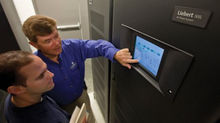Challenges of Noise Distractions in the Control Room
It seems Control Room and Network Operation Center projects are starting to ramp up again after a slow run these past couple of years. We can think of no better time than now to begin talking about some of hidden flaws in NOC and Control Room design that eventually grow into huge pain points for operators. Many of these flaws are extremely important to note as they can drastically increase the risk in safety and functionality of the workforce.
In our last topic of discussion, we gave a general overview of immediate and future related errors in Control Room Design. For the purpose of this discussion, we will highlight how one immediate error, (Noise) can alter an everyday occurrence, into catastrophe.

How Can Noise Be A Risk In Control Rooms?
When designing a Control Room, pain points such as “noise” are commonly overlooked in the concept phase. It is not until the room is already built, operators are in place, and the normal routine of the day is commencing, when noise as a pain point is realized.
Whether in the form foot traffic, conversation, cooling fans, and others, excess noise puts communication between operators and employees in the field at a much higher level of complexity. A perfect example can come directly from our partner at Design Matters in one of their articles.
“Think about this. The average control room that has not been treated acoustically through workstation placement, absorption/deadening materials, directional speakers etc… can easily reach a peak noise level of 85-90 decibels (dB) where ideal noise levels should be around 55-60dB. NOTE: While that may not sound like much, consider that decibels are a logarithmic measurement where 10dB represents a doubling of volume. In this case, that 30dB increase represents eight times (8X) the volume, the difference between a quiet office and standing next to a busy street. Operators who don’t understand or hear one another, have a hard time communicating clearly on the phone and/or radio. Instructions are then misinterpreted creating hazardous possible consequences.
We have witnessed this first hand multiple times while onsite with clients. In one such instance, an operator at a chemical plant was working with his field operator on a fairly serious problem in the plant. During the situation, the control room had become very crowded with people who felt like their presence was needed. With more people, comes more noise. The inside operator instructed the outside operator “no” but the outside operator thought he heard the word “go”. Obviously, there is a big difference between those two words and as a result, the problem quickly escalated. Luckily, the Supervisor, who had once been an operator, realized that the extra visitors were making the communication difficult and he instructed everyone to ‘shut up or leave’. At that point the inside and outside operator were able to communicate clearly and effectively.”

Do Not Let Noise Effect Control Room Operations
This was one example of a situation we see all too often, but rarely gets discussed. Odds are, if it has happened to you, or someone you know, it is likely happening on a larger scale more commonly than gets mentioned. It is for this reason we wish to open a dialogue around these topics as to help prevent professionals in this field from making the same mistakes.
With any luck, a misfortune of this nature will not happen to your crew. Fortunately, a simple conversation around proper noise absorption and dispersion are the first steps in ensuring your room is prevented against an inopportune design flaw.
In an environment where operators are putting in up to 12 hours per shift, fatigue and strain becomes a real problem. And where it is very easy to feel as if you have become “accustomed” to your daily work routine, that is precisely when the minor details could mean the difference between normalcy and calamity. Do not let “noise” be something that brings disaster to your operations.
Conclusion
This is just one of the errors in Control Room design that is commonly overlooked. With that being said, it is also one of the defects that can be easily corrected through trusted consultation and direction. Fortunately, there is a reliable network of professionals in this industry that are more than proficient around this topic.
We will continue to highlight errors in Control Room and Network Operation Center design including, lighting, fatigue, ergonomics, and many more.
Our main goal throughout this first series is to bring awareness of these flaws to light, and exhibit how frequently they happen. Once we have made these flaws apparent, we will then shift focus and begin sharing new content to help prepare and combat the design flaws that could be putting your facility at risk.
Should you ever want to learn more or be in of need of any assistance, we are aligned with multiple companies in Control Room Solutions and would be happy to assist. We are always happy to help.







